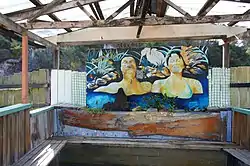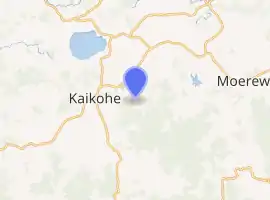Ngawha Springs
Ngawha Springs (Māori: Ngāwhā) is a small settlement approximately five kilometres east of the town of Kaikohe, Northland in New Zealand.
Ngawha Springs | |
|---|---|
 Mural at Ngawha Springs | |
 | |
| Coordinates: 35.409°S 173.860°E | |
| Country | New Zealand |
| Region | Northland Region |
| District | Far North District |
| Ward | Kaikohe/Hokianga |
| Government | |
| • Territorial Authority | Far North District Council |
| • Regional council | Northland Regional Council |
| Area | |
| • Total | 3.67 km2 (1.42 sq mi) |
| Population (2018 Census)[2] | |
| • Total | 147 |
| • Density | 40/km2 (100/sq mi) |
.jpg.webp)
These hot water springs reputedly have therapeutic, balneological properties for those who bathe in their waters, and is the source of the steam used at the Ngawha geothermal field's power station. The nearby Northland Region Corrections Facility is the only prison in Northland.
The New Zealand Ministry for Culture and Heritage gives a translation of "the hot springs" for Ngāwhā.[3]
Ngāwhā Marae and its meeting house, E Koro Kia Tutuki, are a traditional meeting place for the local Ngāpuhi hapū of Ngāti Kiriahi, Ngāti Mau, Ngāti Rangi, Te Uri Hoatau and Te Uri Taniwha.[4][5]
Demographics
Statistics New Zealand describes Ngāwhā Springs as a rural settlement. It covers 3.67 km2 (1.42 sq mi).[1] The settlement is part of the larger Ngapuhi statistical area.[6]
| Year | Pop. | ±% p.a. |
|---|---|---|
| 2006 | 132 | — |
| 2013 | 123 | −1.00% |
| 2018 | 147 | +3.63% |
| Source: [2] | ||
Ngāwhā Springs had a population of 147 at the 2018 New Zealand census, an increase of 24 people (19.5%) since the 2013 census, and an increase of 15 people (11.4%) since the 2006 census. There were 54 households, comprising 69 males and 78 females, giving a sex ratio of 0.88 males per female. The median age was 33.8 years (compared with 37.4 years nationally), with 36 people (24.5%) aged under 15 years, 24 (16.3%) aged 15 to 29, 69 (46.9%) aged 30 to 64, and 18 (12.2%) aged 65 or older.
Ethnicities were 30.6% European/Pākehā, 83.7% Māori, 2.0% Pacific peoples, 2.0% Asian, and 4.1% other ethnicities. People may identify with more than one ethnicity.
Although some people chose not to answer the census's question about religious affiliation, 49.0% had no religion, 28.6% were Christian, 8.2% had Māori religious beliefs, and 8.2% had other religions.
Of those at least 15 years old, 9 (8.1%) people had a bachelor's or higher degree, and 21 (18.9%) people had no formal qualifications. The median income was $17,300, compared with $31,800 nationally. 6 people (5.4%) earned over $70,000 compared to 17.2% nationally. The employment status of those at least 15 was that 33 (29.7%) people were employed full-time, 9 (8.1%) were part-time, and 27 (24.3%) were unemployed.[2]
Waiariki Pools
Facilities are basic, with simple changing facilities. There are no showers on-site, and footwear is recommended. The pools themselves vary in temperature to provide a wide range of hot springs from the rather cool 32 °C / 89 °F to the extremely hot "Favourite" and "Doctor".[7]
The nearby Ginns Ngawha Spa has been closed since 2015.[8]
References
- "ArcGIS Web Application". statsnz.maps.arcgis.com. Retrieved 11 April 2022.
- "Statistical area 1 dataset for 2018 Census". Statistics New Zealand. March 2020. 7000299.
- "1000 Māori place names". New Zealand Ministry for Culture and Heritage. 6 August 2019.
- "Te Kāhui Māngai directory". tkm.govt.nz. Te Puni Kōkiri.
- "Māori Maps". maorimaps.com. Te Potiki National Trust.
- 2018 Census place summary: Ngapuhi
- "Te Waiariki Ngawha Springs". ngawha.com. Parahirahi Ngawha Waiariki Trust. Retrieved 29 July 2018.
- de Graaf, Peter (23 September 2015). "Asbestos casts doubt on Ngawha Springs". Northern Advocate. Retrieved 29 July 2018.